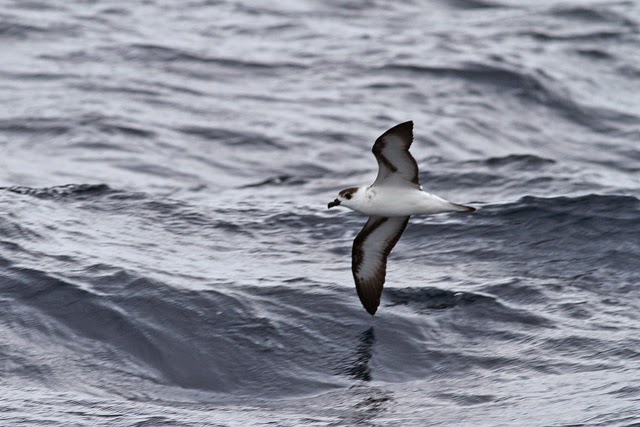However, for me, there was one real purpose of going - to see Black-capped Petrel and study their variability. And for sure, it's a very variable species where I reckon some people may have one extreme - the 'white-faced' individuals - within their search image. I also learnt that Bob Flood and Ashleigh Fisher 'pterodroma petrels' book is bloody excellent too; I knew this as I reviewed it for Birdwatch last year but flicking through ad hoc and then using it with a purpose are two different beasts. What it notes, and I noticed too, are the following macro points on the 40 or so birds that I saw: -
- there is a great array of variability in Black-capped Petrels. I only saw one bird that would fit the 'white-faced' criteria, with all others being 'dark-faced' or intermediate birds.
- underwing is extremely variable, and seems to some extent to be much paler on intermediate and 'white-faced' birds. Though this is just through the one trip I went on.
- they're not like Great Shearwaters at all; though I did go back to the book on one particular 'dark-faced' bird that looked in some respects close to a Bermuda Petrel - though a check of the large bill and the extensive white on the rump/uppertail confirmed it as a Black-capped.
- wing moult varied somewhat; perhaps this being age related. The 'dark-faced' and intermediate birds seen were largely showing some state of wear (inevitable for a non-breeder).
- the birds skirted the boat, sometimes following in the wake loosely. On one occasion, a bird was sat on the sea in amongst Cory's Shearwaters.
All the above is very interesting, with a lot of the Black-capped Petrels seen at a sea depth of c.2,000 feet. Given that all the other species seen, with the exception of Bridled Tern, are regularly seen off the Azores I can but hope to bump into a Black-capped Petrel out there one day. But until I do, here are a fair few photos of this quality species. Recent studies suggest the two types are genetically distinct (probably at subspecies level).
 |
| Photo 1. A typical 'black-faced' individual in active wing moult. |
 |
| Photo 2. Same bird as photo 1 showing what I'd call an average underwing pattern. |
 |
| Photo 3. A 'dark-faced' individual with a particularly dark underwing. |
 |
| Photo 4. Probably what you'd call an intermediate morph, though on the darker side. Note the relatively pale underwing and also the dusky half collar on the hindneck. |
 |
| Photo 5. A 'dark-faced' bird exhibiting wing moult as well as the broad white rump and uppertail. |
 |
| Photo 6. Same bird as in photo 5; showing the dark cap with a dusky hindneck extending into the mantle. |
 |
| Photo 7. An intermediate bird, that initially I thought could be a 'white-faced' bird. However, note the dark smudging behind the eye and also slight hindneck markings. |
 |
| Photo 8. Another photo of an intermediate morph - note the pallid underwing appearance to the true 'dark-faced' individuals. |
 |
| Photo 9. Another example of an intermediate morph, on the paler side than average but still showing black to the eye, dusky hindneck and heavy wing moult. |
 |
| Photo 10. Intermediate morph again showing classic underwing pattern and capped appearance. |
 |
| Photo 11. Perhaps what most people have as a 'classic' Black-capped Petrel - the isolated black cap, obvious white rump and white hindneck. |
 |
| Photo 12. Same bird as photo 11 - note the slight supercilium on this intermediate bird. |
 |
| Photo 13. Illustration of a classic pale underwing - little wing moult going on here. Breeding on Hispaniola spans November to May, so perhaps this could be a young bird? |
 |
| Photo 14. 'Dark-faced' birds especially seemed to be in relatively heavy wing moult. |
 |
| Photo 15. Another intermediate bird, showing a couple of markings on the hindneck; could well be the same bird as in photo 13 and shows relatively fresh wings. |
 |
| Photo 18. Same bird as above, showing the obvious white nape with no dark markings. |


No comments:
Post a Comment